History
The museum began building its permanent collection in 1845 with the initial objective of providing a comprehensive overview of the various European schools of painting since the Renaissance. But at the turn of the 20th century, through several major donations and bequests, the Musée d'art moderne André Malraux became a locus of Impressionism and Fauvism.
Acquisitions by the City of Le Havre
The City of Le Havre was insightfully aware of the importance of the Impressionist School, and was quick to purchase works from Pissarro (The Anse des Pilotes, Le Havre, on a Sunny Morning with the Tide Coming in and The Anse des Pilotes and the East Breakwater, Le Havre, on a Sunny Afternoon in 1903) and Claude Monet (Cliffs at Varengeville, London Parliament and Waterlilies in 1911).
The museum's holdings were further enriched with acquisitions to complement the existing collection, with pieces from the 19th century (Monet, Fécamp Seashore, Courbet, The Wave), expanding into the 20th century (Léger, Hélion, Villon, Dubuffet) and particularly contemporary photography.
The museum's holdings were further enriched with acquisitions to complement the existing collection, with pieces from the 19th century (Monet, Fécamp Seashore, Courbet, The Wave), expanding into the 20th century (Léger, Hélion, Villon, Dubuffet) and particularly contemporary photography.
The Cercle de l'Art Moderne
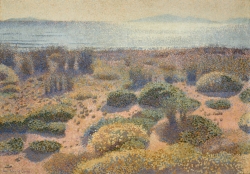
Henri Edmond CROSS (1856-1910), Beach at Vignasse, The Golden Isles, 1891-1892, oil on canvas, 65.5 x 92.2 cm. © MuMa Le Havre / David Fogel
Headed by its president, Mr. Choupay, chief architect of the City of Le Havre, and its secretary-general, Georges Jean-Aubry, the Cercle reunited a group of painters with a team of local businessmen that included co-founders Marande, Senn, Dussueil, Luthy and van der Velde. Together they set out to "facilitate demonstrations of a personal art through the organization of weekly meetings, art exhibitions, chamber music concerts and art education lectures."
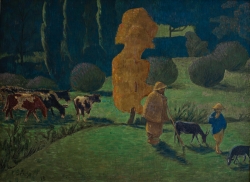
Paul SÉRUSIER (1864-1927), The Shepherd Corydon , 1913, oil on canvas, 73 x 99 cm. © MuMa Le Havre / David Fogel
1900 – The Louis Boudin donation
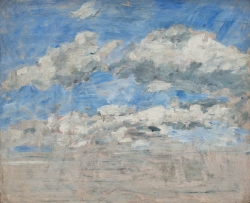
Eugène BOUDIN (1824-1898), Study of Clouds, Blue Sky, ca. 1888-1895, oil on wood, 37 x 46 cm. © MuMa Le Havre / David Fogel
These artworks by Eugène Boudin are an irreplaceable testament to the artist's daily work outdoors.
The Musée d'art moderne André Malraux collection offers the public a unique opportunity to discover the art of Eugène Boudin. Freed from the studio and a concern for finish, the painter demonstrated how the use of colour alone was able to bring to life nuance and detail, which had been, from his beginnings, at the heart of his artistic exploration.
1936 – The Charles-Auguste Marande bequest
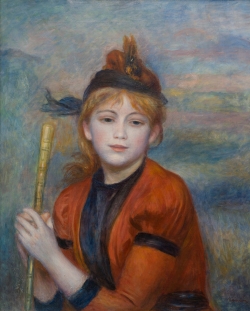
Pierre-Auguste RENOIR (1841-1919), The Excursionist, ca. 1888, oil on canvas, 61.5 x 50 cm. © MuMa Le Havre / David Fogel
This bequest was the core of the museum's Impressionist and Fauve collection, prior to the arrival of the Senn-Foulds donation.
Marande kept abreast of artistic developments and constituted a fine collection that demonstrated his taste for landscape paintings, portraits and interior scenes.
1963 – The Dufy bequest
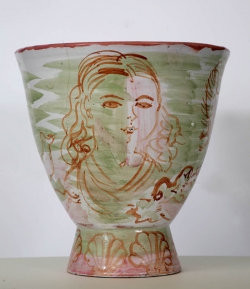
Raoul DUFY (1877-1953), Vase with Bathers and Swans, 1930, ceramic, h. : 29.5 cm / diam. : 29.5 cm. © MuMa Le Havre / Charles Maslard — © ADAGP, Paris, 2013
This collection spans the artist's entire career, from his first Impressionist explorations and Fauve period to his move toward Cézanne and then Cubism, before establishing his own personal style on the margins of pictorial trends.
This bequest reflects the diversity of Dufy's art from painting and drawing to tapestry and ceramics.
2004 – The Hélène Senn-Foulds donation
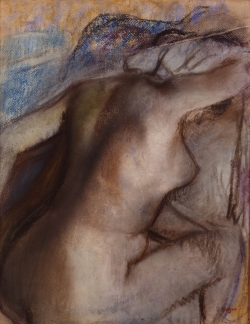
Edgar DEGAS (1834-1917), After the Bath, Woman Drying Herself, ca. 1884-1886 / 1890 / 1900, pastel on wove paper, 40.5 x 32 cm. © MuMa Le Havre / Florian Kleinefenn
Through his in-depth knowledge of the artistic milieu, he acquired major works by Courbet, Delacroix and Corot, and especially Impressionist artists such as Renoir, Sisley, Monet, Pissarro, Guillaumin and Degas. His collection also included Post-Impressionists such as Cross, Nabis such as Sérusier, Vallotton, Bonnard and Vuillard, and Fauves such as Derain, Marquet and Matisse.
Thanks to Hélène Senn-Foulds' donation of 71 paintings, 130 prints and drawings, and 5 sculptures, the Musée d'art moderne André Malraux now boasts one of the richest Impressionist collections in France.
2009 — THE SECOND HÉLÈNE SENN-FOULDS DONATION
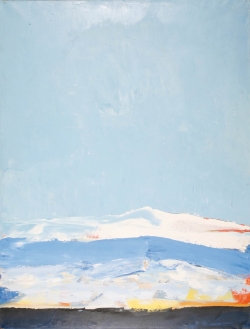
Nicolas de STAËL (1914-1955), Landscape, Antibes, 1955, oil on canvas, 116 x 89 cm. © MuMa Le Havre / Charles Maslard — © ADAGP, Paris, 2013
67 new artworks thus joined the museum in the form of 42 paintings, 15 drawings, 5 prints and 5 sculptures.
Son of Oliver Senn, Edouard Senn (Le Havre 1901-Sallanches 1992) was, like his father, passionate about the art of his time. He moved to Paris in 1940 and began his own collection, taking an interest in the artists of the interwar period, such as Charles Lacoste, André Dunoyer de Segonzac and Yvan Pougny. But his preference leaned more toward works painted between 1950 and 1980, like those of Hungarian-born Endre Rozsda, Pierre Lesieur, Roger Muhl and Nicolas de Staël. Among other extraordinary works, his collection includes a watercolour from Pablo Picasso's Blue Period.
2014 — THE PIERRE-MAURICE MATHEY DONATION
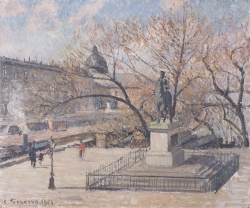
Camille PISSARRO (1831-1903), Statue of Henri IV and Hôtel de la Monnaie, Morning, Sun, 1901, oil on canvas, 46 x 55 cm. © MuMa Le Havre / Charles Maslard
PHOTOGRAPHY
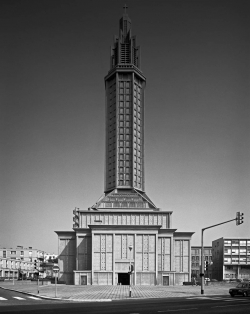
Gabriele BASILICO (1944-2013), Le Havre. Saint-Joseph Church, 1984, colour photography, gelatin silver bromide print, 60 x 50 cm. © MuMa Le Havre / Gabriele Basilico
MuMa has contributed to this historical record by encouraging more photo campaigns, at the very moment the city centre rebuilt by Auguste Perret was listed as a UNESCO world heritage site (2005).
Drawing inspiration from André Malraux's idea of an imaginary museum or "museum without walls", MuMa has also added to its collection of photographs that explore the notion of landscape in direct link with its painting collections (Thibaut Cuisset, Véronique Ellena, Stéphane Couturier, etc.).

